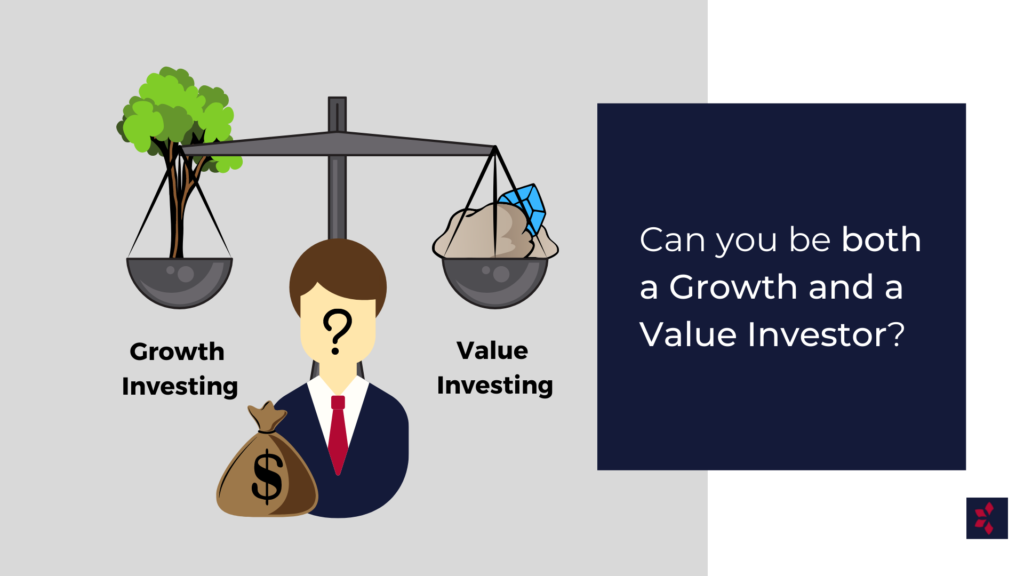Can You Be Both a Growth and a Value Investor?

Growth and value investing are two types of investing styles, each with strong proponents and opponents… but can you be both a growth and value investor? The short answer is yes.
Warren Buffett, perhaps the investment industry’s most devout value investor, has lamented more than once that his investment discipline did not allow him to purchase Apple or Amazon in the company’s early days.
Looking at his decades of success, Buffett has not and is never likely to change his value regimen.
However, he may have somewhat tempered his position over time, opportunistically adding historically growth character stocks to his portfolio when their price was low. Once when confronted about the presence of growth stocks in his fund he responded, “Growth and value are joined at the hip.”
Yes, You Can Be Both a Growth and a Value Investor
The majority of professional equity managers would not label themselves as applying exclusively growth or value fundamentals to selecting equity portfolio holdings.
Almost all equity managers have a leaning to one style or the other but may invest in both growth and value stocks, which means that the resulting portfolios are generally representative of the overall market and have no intentional style bias.
Thus, the portfolios are labelled by equity style analysts as “neutral.” The individual holdings do not combine growth and value criteria but rather, may be selected independently for their growth or value characteristics.
Style neutral equity portfolios tend to track very closely to the benchmark index (e.g. TSX 300). In fact these investment managers are often labelled “closet-indexers,” especially where portfolios are not focused, holding a broad representation of the market.
Neutral Equity Management Style Validated
Over the past two decades, the major equity market index providers MSCI, S&P Dow Jones, FTSE Russell and Morningstar have all developed specific style indices by which to benchmark style-specific equity managers.
At a minimum, the broad equity market is allocated to Growth, Value and Neutral Indices.
Stock in these indices are re-allocated on a regular basis, as when a previous high growth company matures and becomes a slower growth company it takes on a more value profile.
Growth at a Reasonable Price (GARP)
There are also equity managers who adhere to a specific stock selection process that simultaneously applies a combination of growth and value criteria.
This stock selection process known as “Growth at a Reasonable Price” (GARP) focuses on growth companies, but with an awareness of value indicators. Or, the reverse—it looks for value stocks that also have the potential for earnings growth.
In other words, GARP investors are looking for companies that combine the best growth and value criteria. They seek to invest in stocks that show consistent earnings growth above broad market levels while excluding companies that have very high valuations.
As outlined in our previous Growth vs. Value article, value managers typically hold lower P/E (Price to Earnings) stocks while growth managers will hold much higher P/E stocks. Looking for the best of both worlds, GARP investors employ the PEG ratio: PE/G.
The PEG shows the ratio between a company’s Price to Earnings ratio (valuation) and its expected earnings growth rate (G) over the next several years. A GARP Investor looks for stocks with a PEG of 1 or less, indicating the stock is trading at a reasonable price.
Using the GARP approach:
- widens the investible universe of potential investments compared to either strict value or growth investing;
- contributes to investors enjoying a more predictable return throughout different market cycles; and
- in a stock market downturn, one could expect the return of GARP investors to be higher than those of pure growth investors but subpar to strict value investors (and vice versa in a market upturn).
Peter Lynch, a long-time mutual fund manager at Fidelity Investments, famously said, “Selling your winners and holding your losers is like cutting the flowers and watering the weeds.” In others words, hold on to your best performing stocks and sell your worst performing stocks. A strict adherence to growth or value investing may not allow this, whereas GARP does.
Where do Dividend Investors Fit In?
The most successful equity investors in the world have employed numerous equity styles and have all achieved solid performance over the years. The commonality to all their success? Strict adherence to their investment acumen and long term investing.
Dividend investors can find opportunities by employing all three investment styles, GARP, Growth and Value as they invest for the long term.
This content is provided for general informational purposes only and does not constitute financial, investment, tax, legal or accounting advice nor does it constitute an offer or solicitation to buy or sell any securities referred to. Individual circumstances and current events are critical to sound investment planning; anyone wishing to act on this content should consult with his or her financial partner or advisor.